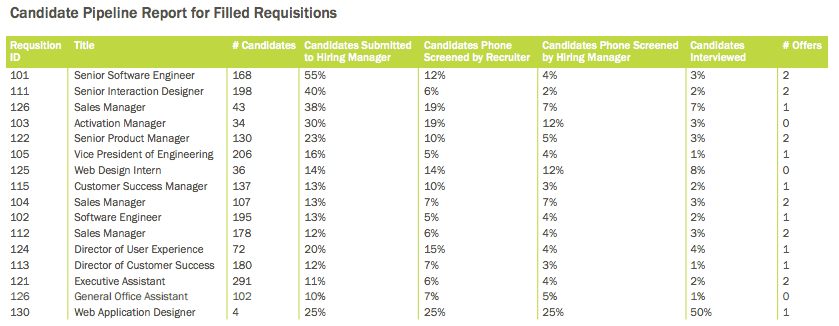How To: Measure the Quality of Your Candidates

With the growing need for employers to gain a crucial competitive advantage when it comes to recruiting top-quality candidates, there is a much sharper focus on the value of talent and how talent can have a direct impact on culture, productivity, performance, reputation and customer satisfaction. Hiring poor candidates can have a detrimental impact on the organisation, as discussed before, with SHRM estimating that it can cost up to five times the person’s annual salary, which can be even higher depending on the person’s tenure and seniority.
With this new found emphasis on quality of hire (QoH), a vital measure has somewhat flown under the radar: Quality of Candidates/Applicants. What employers seem to sometimes forget is that Quality of Applicants (QoA) is positively related to QoH. The initial applicant pools generated during recruitment efforts has implications for the success of the company. This means that employers need to not only ensure that they are attracting the ‘right’ candidates but they also need the right metrics to measure the quality of these candidates. This data can really aid employers in more strategic decision-making (e.g. focusing on channels with the most ‘quality’ candidates) and also better predict future performance. Here, we break down the 5 metrics you need to measure the quality of your candidates:
1. Percentage of Candidates Coming From Referrals
The effectiveness of well-run employee referral programs cannot go understated. It is a fast and inexpensive way to make hires as it allows you to turn your workforce into a recruiting team. These programs automatically extend your reach as your employees start to advertise your open position on their channels.
It has also been proven that employee referral programs are the best way to hire high-quality candidates. This is because employees who are actively involved in referral programs know they have a role to attract candidates with highly-valued skills and experience and also, their willingness to screen candidates before the interview stage means the candidate pool is of higher quality.
2. Number of Applicants / Number of Candidates
This is a useful metric to measure as it immediately gives you an insight into the types of candidates you are attracting for the open position. This is the ratio of the number of applicants who have applied for your position to the number of applicants passed on to the hiring team as a ‘candidate’. In other words, this is where an applicant becomes a candidate after the recruiter reviews their resume, after which a phone interview may take place with that same recruiter or someone else from the hiring team for additional screening. This additional screening is critical as it can reduce the costs associated with interviewing candidates who you quickly realise would not be fit for the role.
This metric is primarily dictated by the accurate nature of the job specification and how senior the role is. For example, more senior and experienced roles typically attract fewer applicants. Whatever the nature of the job being advertised, your goal here is to increase the number of candidates to pass on to the hiring team. If you are able to attract larger pools of quality applicants, you have the opportunity be more selective in your hiring decisions. Note: This does not mean you become more lenient with less qualified candidates – only make more efforts to increase the number of candidates based on decided criteria.
3. Number of Candidates / Number of Candidates Selected for Interview
 This metric measures the number of candidates selected for additional screening versus the number of candidates selected for an in-person interview. This is where the recruiter ‘hands off’ the candidate to someone from the hiring team for additional screening who then picks a number of candidates for interview. The member from the hiring team analyses the candidate’s resume and the comments by the recruiter and determines if they have qualified for an interview based on their skills, work experience, education etc. Again, this is another conversion metric you want to increase as much as possible so the hiring team have good pool of quality candidates to select from.
This metric measures the number of candidates selected for additional screening versus the number of candidates selected for an in-person interview. This is where the recruiter ‘hands off’ the candidate to someone from the hiring team for additional screening who then picks a number of candidates for interview. The member from the hiring team analyses the candidate’s resume and the comments by the recruiter and determines if they have qualified for an interview based on their skills, work experience, education etc. Again, this is another conversion metric you want to increase as much as possible so the hiring team have good pool of quality candidates to select from.
According to Amy Caswell, Director of Talent Acquisition at Motion Recruitment Partners, you need aim for at least 75% of candidates to be selected for the interview. Anything less than that means the candidates you select aren’t meeting the expectations of the hiring team. This is where communication between the recruiter and the hiring team becomes paramount.
4. Number of Interviews / Number of Offers
This metric gives you a further indication about the quality of the candidates, this time from the hiring team who are now directly involved in the recruitment process. Whereas with the first two metrics your goal was to increase the conversion rate, the number of interviews:number of offers ratio should be quite low. If the ratio is too high (for example 20:1), this means that there are more candidates being interviewed without receiving a job offer. This can cause candidate frustration which will reflect badly on your company’s reputation. It also reflects badly on your pre-interview assessment process.
Interviewing can be expensive for companies so at this stage, it is important to have a strong feeling about the candidate’s abilities and their willingness to accept the job. The goal here is to get your ratio as low as possible. The lower the ratio, the higher the quality of candidates and less time that is being spent in the hiring process.
5. Desired vs. Actual Job Performance

This is the only metric that can’t be measured during the actual recruitment process. It is more of a retrospective metric based on the candidate’s performance. It can be created in checklist format whereby you list the tasks, goals and responsibilities required for this role before hire and subsequently analyse the performance of the new hire based on this criteria. Think of it as a subset metric of QoH. Measures that can be used here include performance appraisals every quarter, months until promotion and sales volume per hire.
Some supplementary measures you could also use include retention rate of new hires and manager satisfaction with the job performance of the new hire. The purpose of using measures such as this is for confirmation purposes that the hired candidate is of the sufficient quality. A candidate who is hired and subsequently performs very poorly will demand a re-examination of the assessment process.
So those are 5 metrics you can use to measure the quality of the candidates that you are attracting for your role. As we mentioned before, it has become absolutely essential to optimise your recruitment process and this starts with tracking and analysing the data. Jobvite have developed a dashboard which tabulates all of this data to give you a good overview of the recruitment activities.
(RELATED: The Ultimate Recruiter’s Handbook 2016)

